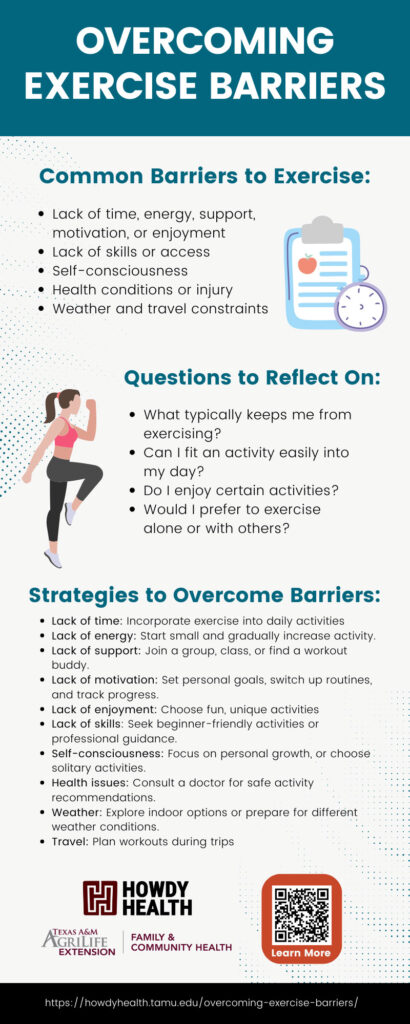When it comes to exercise, there are lots of things that can get in the way of our good intentions. Asking yourself a few questions can help you break down the barriers that keep you from being physically active.
Important questions to ask yourself:
What are the things that most often keep me from exercising?
Often cited barriers include:
- Lack of time
- Lack of energy
- Lack of support
- Lack of motivation
- Lack of enjoyment
- Lack of skills
- Lack of access
- Self-consciousness
- Injury/Illness/Health conditions
- Weather
- Travel constraints2,3,4,5,6,7,8,9,10,11
Is there an activity that I can easily fit into my day?
The more easily an activity fits into your day, the more likely you’ll be able to do it regularly.1 Look at your calendar and mark any place you have 30 minutes. Choose the slot that’s the least hectic and mark it down as an appointment that can’t be cancelled. There is no reason to feel guilty about scheduling the time you need to get and stay healthy, so you can do all the other things your life requires.
Is there an activity (or activities) I especially enjoy?
The more you enjoy an activity, the more motivated you’ll be to want to do it often.1 Sometimes choosing the simplest activity is the most enjoyable because it doesn’t require much preparation, for example walking or jogging. Just lace up your athletic shoes and head out the door. Enjoyment for you, however, might be something different than you’ve ever thought of before. Think outside-the-box about what fun activities get your heart pumping and your muscles moving. Read on for some ideas.
Do I want to participate in an activity with other people or on my own?
- Having a workout buddy or participating with a group has the benefits of socializing, relationship-building, motivation, and accountability from other participants.
- Working out on your own has the benefits of solitude, working through your thoughts, praying, mindfulness, and opportunities for listening to music, podcasts, and audiobooks.
- You might also choose a combination of both. This might be simply talking with a friend on the phone while you walk or ride a stationary bike. You could also choose a partner or group activity a few days a week and solitary activities on alternating days.
Ideas for overcoming your barriers
So how can you overcome your barriers? Here are some ideas that may help:
Lack of time
If lack of time is one of your barriers, start by looking at your schedule. Are there sedentary times that could be turned into active times. For example, riding a stationary bike while watching tv or doing calisthenics at the commercial breaks? Are your kids playing sports or practicing with the marching bank, why not walk around the field while they practice? Try biking or walking to the store when you need something or commuting to work. You can also turn chores you already do into physical activity – sweep, mop, vacuum, scrub, and mow with vigor. If you have a phone call, consider walking while talking or ask a colleague to join you for a walking meeting.3,4,10 Try a 7-minute workout. You can find the exercises and information here or try this 7-Minute Workout app. Do it twice when you have a bit more time. Have a goal of stringing three or four 7-minute workouts together each day of the week and you’ll be well on your way to meeting the recommendation of 150 minutes of moderate physical activity per week.
Lack of energy
Not feeling as if you have the energy to exercise is tricky because being fit can help you gain energy. So, remember that gaining energy is a benefit of physical activity. Start slowly with small goals. For example, try getting up a few minutes earlier and taking a 10-15 minute walk before work.2 Take your athletic shoes to work for a short walk at lunch and/or before you come home.3,7 Take a short after dinner walk. When you begin an exercise routine, start by exercising on your day(s) off when you may feel more rested and ready. Once those days become a habit, gradually add other days to your exercise routine.
Lack of support
Having support to exercise can help you stay motivated and keep you accountable. Ask a friend or family member to exercise with you. If you can’t find someone to workout with, consider asking them to encourage you and keep you accountable anyway. Join a walking group, exercise class, or community sport for accountability – and fun! “Research shows that joining a group or taking a class with others increases exercise time and health benefits.”3 Consider hiring a personal trainer, coach, or instructor for the activity of your choosing. If that’s not in your budget, contact your local community center, parks and recreation office, or your local church or faith community to see if they have any free or low-cost lessons or classes in your area.
Lack of motivation
Motivation to be active is a complex challenge. Sometimes finding the motivation to be active means finding your “why.” Think of why you want to be active. Is it to have energy, improve your mood, increase your strength, lose weight, improve your blood glucose, cholesterol, or heart health? Be specific, for example, do you want to have energy to play with the kids in your life? Do you want to have strength for specific daily tasks? Do you want to improve your mood for better relationships or better focus at work or play? Even though exercise requires effort, knowing your “why” can help motivate you toward being more physically active.
If lack of motivation is the result of boredom with your exercise routine, don’t be afraid to switch it up.7,9 If you’re doing the same workout daily, try a new activity or switch to a new location or change your route. You can also change the tempo of your workout to make it more interesting and beneficial. Walk fast for one minute and then more slowly for the next. When lifting weights try time-under-tension, for example, count slowly to four on both the upward and downward motion. Do you have a goal-oriented or competitive spirit? Consider joining community sports or working toward a 5K- or 10K- walk or run. Goals can add motivation and enjoyment to your efforts.
Tracking your activity in an app or on your calendar or planner can also help you see your progress and keep you motivated. Reward yourself for meeting goals – big and small.
Lack of enjoyment
One of the best ways to overcome the lack of enjoyment barrier is to find an activity that feels more like fun than work. Think of your personality and explore solitary or group activities accordingly. Think out-of-the-box. Go “old school” with roller skating, hula hooping, jumping rope or on a trampoline.11 How about square-dancing, jitterbug, or hip-hop? Try tennis, pickleball, racquetball, or handball. Consider gardening, rock climbing, martial arts, adult gymnastics, swimming or water aerobics. Have a friend teach you something new or take lessons at your community center, YMCA, or other activity facility. Contact your local parks and recreation office for ongoing programs. Investigate other unique exercise opportunities in your community
Lack of skills
Physical activity doesn’t require any special skills. Walking is an easy and effective choice. If you feel unsteady, use walking poles to help maintain your balance.3 If you want to participate in another type of activity that you’re unsure about performing, seek out a fitness professional to get you started.2,10 Talk with a personal trainer, physiologist, physical therapist, coach, dance instructor, or look for lessons by qualified professionals through your local community center, parks and recreation office, YMCA, or gym. Many gyms offer a free service to show you how to use the equipment and set up a routine that will help you reach your goals.11
Lack of access
Lack of access to an affordable and safe place to be physically active can be a multifaceted barrier. If you can’t walk safely in your neighborhood, consider driving to a safer location or joining a gym or other recreation facility. Find out if your employer has on-site workout options or facilities.4 If budget is a barrier, consider doing free workout videos at home.4 Look for videos by qualified exercise professionals, who have safety and good form in mind with a warm up, options for different levels of fitness, and a cool down.12 Join free community groups, such as walking, hiking, or running clubs. Look for individuals offering free or low-cost group classes, like boot camps, Zumba, or aerobics in your community. Community centers, parks and recreation offices, and churches are good places to start.
Self-consciousness
If you feel uncomfortable about your skill level or how you look to others, firstly, know that you’re not alone. We are all beginners before we become proficient at anything, and we’re out-of-shape before we’re in shape. Be aware that most people are not looking at you or your skill, but rather focusing on their own efforts. Set your goals based on your abilities and try not to compare yourself to others.9 Most of us struggle with this, so give yourself grace. Any kind of movement is good. Don’t criticize yourself when you wouldn’t criticize someone else. Celebrate your successes, but don’t beat yourself up if you don’t do what you were planning.
If you don’t want to be among others, consider a solitary activity like walking, jogging, or online workouts – there are a myriad of choices online from barre workouts and dancing to kickboxing and Pilates. Find something you feel good doing. Be kind to yourself.9,11 If you’re really struggling with a particular activity, take a break and come back to it on another day. Switch classes, instructors, or locations if you’re not feeling comfortable, or choose a new type of activity altogether.
Injury/Illness/Health conditions
Having a current (or chronic) health condition, or recovering from an injury or illness, can make exercise a challenge, especially if you have pain issues or physical restrictions. Talk with your doctor2,3 and see if you can work with a physical therapist or sports rehabilitation specialist. Learn how to warm up and cool down to help prevent injury.4,10 Talk openly with them about your pain level, but also about activities you think you’d enjoy and how you might go about performing or working toward them. Ask if swimming, water aerobics, or water sports would be options for you and whether they have any facilities for these activities, which can sometimes be prescribed and/or supported by your insurance coverage. Don’t give up. Most conditions benefit from physical activity. Keep the end goal in mind to stay motivated. Small steps are still steps in the right direction.
Weather
If the weather is often a barrier for you, take it inside. You could choose online exercise classes (aerobics, dance, strength training, yoga), indoor swimming, stair climbing, indoor cycling, or calisthenics,10,11 or create your own. Consider a gym or YMCA with lots of indoor options. You can also enjoy a walk at a local mall on bad-weather days. If outside exercise is your joy, then the other option is to be prepared. Get the right clothing layers to allow you to workout in hot and cold conditions. Choose an earlier or later time to workout to stay cooler in the summer heat. Keep water on hand to stay hydrated. Find routes with more trees providing shade in the summer. Routes lined with trees, houses, or other buildings can also help block the wind in the winter. Bundle up in layers that can be shed as you warm up during those chilly winter days.
Travel Constraints
If travel is often a barrier for you, set your mind on not letting your workout fall to the wayside. Find out if your accommodations have gym facilities or a swimming pool. You can also pack a jump rope or resistance bands for some workout options. Take the stairs at the hotel, instead of using the elevator. Check to see if your gym has branches or reciprocal memberships with other gyms you can use at regular destinations.11 Find out ahead of time if your location is safe for on foot exploration – a great way to get activity while seeing the sites. The main thing is to plan activity into your travel schedule. Look at your schedule and block out the time when you’ll exercise. This is especially important if you travel a lot for work, so that you don’t regularly miss your workouts.
“Given that the elimination of even one barrier may be enough to change the health behavior intentions of many people, effort should be put towards eliminating or reducing these in [your] work and nonwork life.”8
Here’s one more idea for breaking exercise barriers – Join one of our fun free programs that are open to everyone.
Infographic
Download the PDF or share the image below to help others learn more about overcoming exercise barriers.
- Baylor Scott & White Health. Choosing the right workout program: 3 tips for exercise beginners. May 25, 2021. Accessed August 26, 2024. https://www.bswhealth.com/blog/choosing-the-right-exercise-program-for-you.
- American Diabetes Association. Overcome barriers and get moving. Accessed August 30, 2024. https://diabetes.org/health-wellness/fitness/overcoming-barriers.
- American Heart Association. Breaking down barriers to fitness. January 18, 2024. Accessed August 30, 2024. https://www.heart.org/en/healthy-living/fitness/getting-active/breaking-down-barriers-to-fitness.
- Centers for Disease Control & Prevention. Overcoming barriers to physical activity. April 5, 2024. https://www.cdc.gov/physical-activity-basics/overcoming-barriers/index.html.
- Hunter JR, Gordon BA, Bird SR, Benson AC. Perceived barriers and facilitators to workplace exercise participation. International Journal of Workplace Health Management. October 3, 2018. Accessed September 13, 2024. https://www.emerald.com/insight/content/doi/10.1108/IJWHM-04-2018-0055/full/html.
- Kang HJ, Wang JCK, Burns SF, Leow MK-S. Is self-determined motivation a useful agent to overcome perceived exercise barriers in patients with type 2 diabetes mellitus? Frontiers in Psychology. June 17, 2021. Accessed September 13, 2024. https://www.frontiersin.org/journals/psychology/articles/10.3389/fpsyg.2021.627815/full.
- Mayo Clinic. How to overcome the top 5 fitness barriers. July 27, 2015. Accessed September 2, 2024. https://newsnetwork.mayoclinic.org/discussion/how-to-overcome-the-top-5-fitness-barriers/.
- Mazzola JJ, Moore JT, Alexander K. Is work keeping us from acting healthy? How workplace barriers and facilitators impact nutrition and exercise behaviors. Stress and Health. 2016;33(5):479-489. https://doi.org/10.1002/smi.2731.
- Mind Organization. Overcoming barriers to physical activity. October 2023. Accessed September 4, 2024. https://www.mind.org.uk/information-support/tips-for-everyday-living/physical-activity-exercise-and-mental-health/overcoming-barriers-to-physical-activity/.
- U.S. Department of Homeland Security. Overcoming fitness barriers. October 18, 2023. Accessed August 30, 2024. https://www.dhs.gov/employee-resources/news/2023/10/18/overcoming-fitness-barriers.
- Victoria Department of Health. Physical activity – overcoming excuses. February 20, 2023. Accessed August 30, 2024 https://www.betterhealth.vic.gov.au/health/healthyliving/Physical-activity-whats-your-excuse.
- Hermann, L. Exercise at home with YouTube: Videos to avoid and videos to Watch. American Council on Exercise, September 16, 202. Accessed September 5, 2024. https://www.acefitness.org/resources/everyone/blog/7660/exercise-at-home-with-youtube-videos-to-avoid-and-videos-to-watch/



